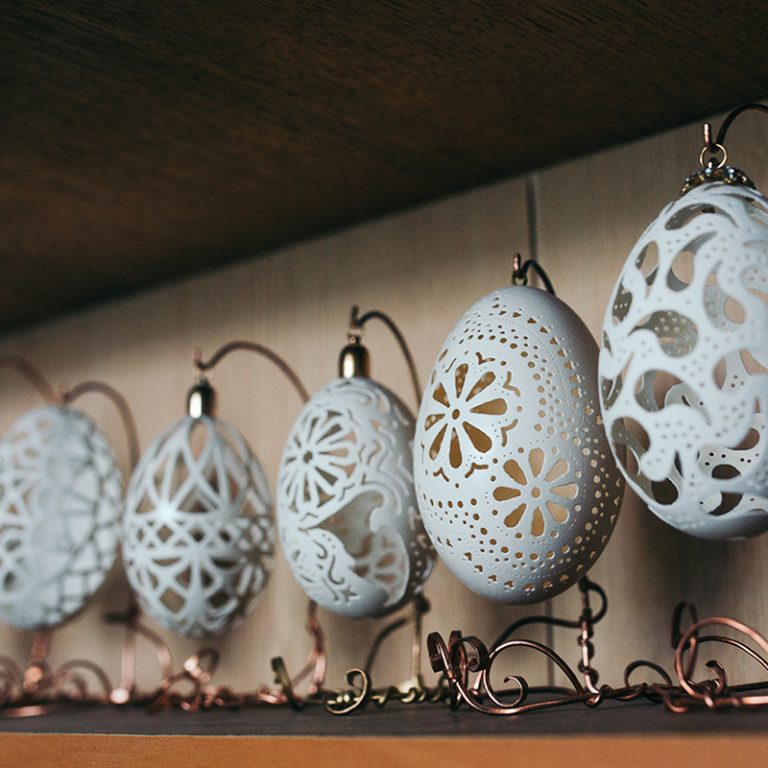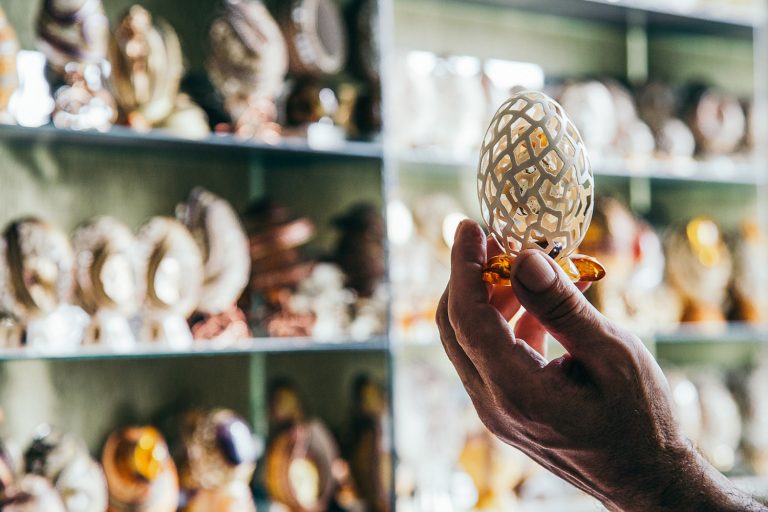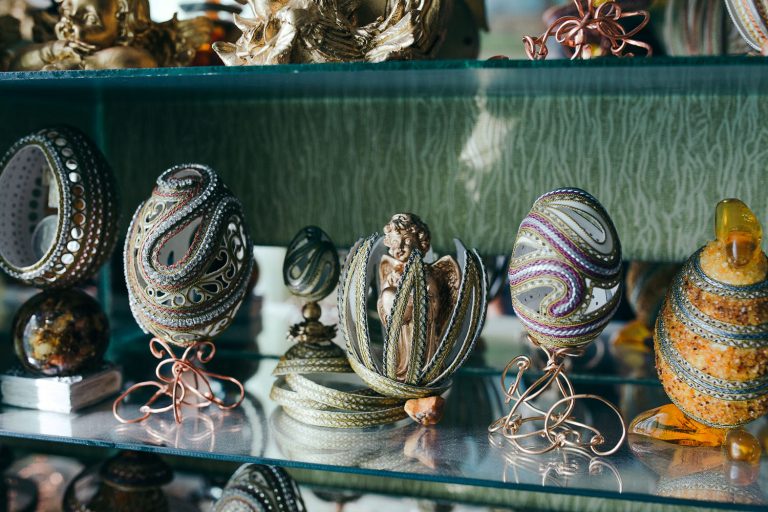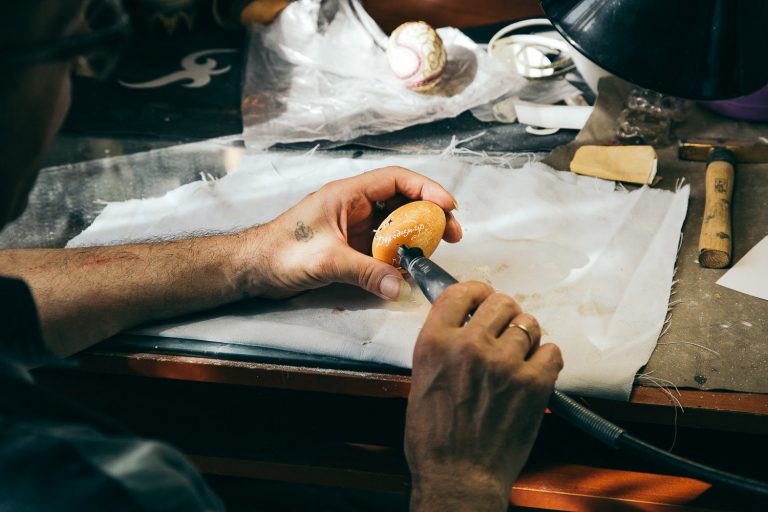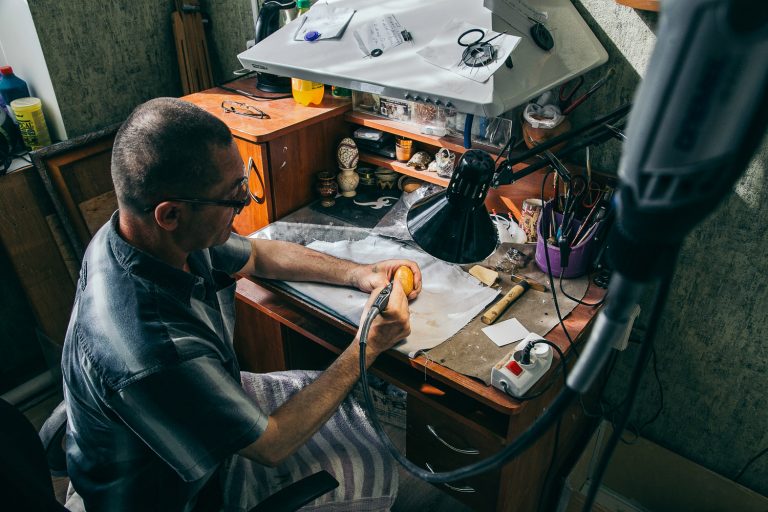Anatolii Boiko decorates the eggshell in a way that surprises art connoisseurs and experienced scientists. An artist from Volodymyr-Volynskyi in Volyn invented a unique technique of decorating eggs — he “dresses” them in metal, decorates them with precious stones, and gives them an unusual shape. Anatolii’s skill has long been recognised in the world, but he wants his achievements and experience to remain the property of Ukrainians.
Easter painting is a decorative and applied art that has long been one of the symbols of Ukraine. The tradition of decorating eggs with various ornaments existed in pre-Christian times, but researchers believe that Easter painting in its modern sense appeared after the adoption of Christianity. It was with the adoption of Christianity that egg decorating became one of the Easter preparation traditions. The pysanka — a decorated egg — has long symbolized life, the universe, and decoration ornaments and techniques vary depending on the region.
Boiling with some dye, scratching off the dye, wax dropping, painting — these are all different techniques for making Easter eggs — all these are different techniques for making Easter eggs. The ethnographers call pysanka decorated eggs, for which wax is used. In general, a variety of natural materials have been used for decorating eggs: decoctions of onion husks, bark and leaves of trees, etc.
During the Bolshevik occupation, they wanted to eradicate Easter from the list of holidays that Ukrainians should celebrate, so Easter painting and egg decoration was banned as a “religious and harmful activity”. As a result, the tradition of painting eggs was suspended almost all over Ukraine. Residents of remote Carpathian villages, as well as Ukrainians in Canada and the United States, have tried to preserve a long tradition. Some families in different cities, towns and villages celebrated Easter secretly, risking their lives.
Interest in the making of Easter eggs resumed in the 1960s. Since then, Easter eggs have been collected in many museums. One of the unique places is the Museum of Easter eggs in the city of Kolomyia, the world’s only museum of traditional egg decorating. The museum’s collection includes more than six thousand eggs.

Anatolii. To invent new technology
Anatolii Boiko is a craftsman who became famous all over the world thanks to his inventions related to the decoration of eggshells. When you look at the man’s work, it seems that he managed to outwit the laws of physics: he frames the eggshell with bronze and silver lace, encrusts it with various precious stones and even pulls it into a spiral. Because of this, Anatolii, who lives in the city of Volodymyr-Volynskyi, used to be called Ukrainian or Volyn Fabergé, but the artist does not like it. He explains: to think so is like misleading yourself:
Peter Carl Fabergé
Russian jeweler of the 19 century, founder of the eponymous firm and dynasty of masters of jewelry.“Fabergé was mostly making [working on] stone, metal or wooden eggs. I work with the eggshell itself, using traditional Ukrainian techniques, only instead of wax and paint I use metal.”
By profession, Anatolii is a wood carver. He says he has seventeen folk art techniques. He paints pictures, makes graphics, does wickering, carves wood and eggshell, does embroidery and crocheting. He says that he started to try his hand at applied art as a child, so there were no hesitations with the choice of education — he received a diploma in “Carving and Art Design” at the Dubno Vocational School.
Anatolii’s life was radically changed by military service and participation in war actions in the First Karabakh War. The man is reluctant to talk about those events. He returned as a disabled person and he says the past keeps nagging him. According to Anatolii spent ten years under treatment while trying to earn a living. So he mastered working professions and went to work in neighbouring countries. The artist comes from the village of Bugliv, on the border of Halychyna and Podillia, and settled in Volodymyr-Volynskyi, his wife’s hometown.
The first Karabakh war
Armed conflict between Armenians and Azerbaijanis in 1987-1994, mainly over control of Nagorno-Karabakh region.slideshow
He started decorating eggs in 2009. He says, he was not very attracted to the traditional ‘pysanka’ decoration technique, because there were already many pysanka articles and he wanted to create something special. So he carved on an eggshell for some time, admiring the symbolism of the ornaments of Trypillian culture. However, the artist-inventor (as Anatolii calls himself) could not stop there:
“I’m looking for something new, here’s my principle: using materials that everyone else is using but making something that is non-existent, that has no analogues.”
The idea of a new technique of decorating eggs came to Anatolii’s mind due to one case, which he perceived as a challenge to himself. Once he was visiting his old friend, who inherited an official copy of one of Fabergé’s eggs from his late father. Examining this work of art, a friend asked, “You wouldn’t dare, would you?”
“And that affected me, you know? It sparked me. How many eggs did I break! But when I realised that the third of all the eggs came out well, and the egg [shell] withstood the strain of metal, that meant I was on the right side of things, and that was the area to experiment with a bit more, in order to achieve what I wanted. And that’s how this art developed in me. Now I have been working in that technique for ten years, I am already a record holder in Ukraine.”

Unique works of art
Work on one product of Anatolii’s lasts from several days to six months. Before inlaying the egg, its shell must be prepared. First, at both ends of the egg, the craftsman pierces the holes through which he blows out its contents. Then he washes the egg several times, whitens it from the outside and leaves it to dry for two or three months. Only a smooth surface can be finished.
Next — a whimsical and complex process of decoration, which Anatolii creates first in his imagination, because he does not work with sketches. When the product is ready, he covers it with a special varnish. The artist very carefully selects materials for the decoration of his products, because he wants them to please people for as long as possible:
“When a person bought a thing, and it darkened in two years, it spoils both the maker’s image and spoils the owner’s mood.”

Anatolii says that all the techniques he invented to decorate the eggshell is the result of painstaking research, and the secrets he has not yet revealed:
“The eggshell is basically a mix of calcium, silicon, and chalk, if you wish. I myself study trigonometry and chemistry quite intensively because without knowledge of these sciences it is unrealistic to build and concentrate everything. According to the laws of physics and chemistry, the shell can only be dissolved, it is unrealistic to stretch it out. But I manage to do this.”
The artist decorates various types of eggs: chicken, goose, turkey, quail and even ostrich ones. By the way, ostrich eggs are ordered from the United Arab Emirates and Australia, because only these are suitable for applying a delicate pattern. Anatolii explains that ostriches kept on local farms do not have time to form eggshells, and bio-additives and animal lifestyles affect the eggshell’s quality not in the best way.
Anatolii says that the eggshell is an extremely fragile material, so one careless or wrong move — and the work falls apart, even if he did made a dozen similar things before.
For his first artworks, Anatolii used tools he had on hand: a screwdriver and a nail grinder. Then he raised money and bought an American jewelry drill.
These tools were enough until Anatolii started decorating ostrich eggs. Simple drills “do not take” them, only the diamond ones do. He found a solution to the problem in the dentist’s office: he buys diamond drills from doctors or agrees to pick them up by barter. Anatolii makes some parts and tools for his own work. For example, special hooks for removing the eggshell are from the spokes of racing bikes, because their steel is very strong. But in the arsenal of his tools there are also imported drills for metal.
One of Anatolii’s inventions is the metal framing of the eggshell. To do this, he uses copper and high-quality Italian jewelry wire, as well as silver. Silver forging on an eggshell is one of the greatest achievements of the artist. For inlay he uses jewelry, precious metals, Swarovski stones, porcelain, amber crumbs.
Swarovski
Austrian company specialising in the production of bulk crystals, jewelry, faceting of precious stones.The metal on the shell is fixed with special resins that crystallise and have the appearance of glass. The composition of this substance, Anatolii also came up with himself. He says that he constantly turns to primary sources, that is, he studies not only the chemical properties of various materials, but also tries to find out how they were used in ancient times.
But the process of stretching the eggshell can take more than a year. Anatolii gives it the shape of a spiral, decorates it with metal and hangs it. He says that it lengthens literally by a millimeter, so this process requires patience. Stretching under its own weight, the shell becomes more elastic and strong. Whether the product is suitable for further work the craftsman checks by ear: if he hears even the slightest crack, then the egg is not ready. According to Anatolii, in this way he managed to pull out some eggs up to ten centimeters in size to a size six times larger than their natural one.
Anatolii’s products surprise many: he makes elegant boxes out of eggs, lamps, can completely change their shape, for example, to lengthen or even put in each other.
“I also have my own secret, my own mathematical calculations. As they say, there is no magic or tricks. If you think correctly and wisely, calculate — everything can be done.”

Recognition in Ukraine and the world
Anatolii conducts free excursions. He regularly donates a number of his works to museums and auctions to send the proceeds to the Ukrainian military in the Russian-Ukrainian war or to volunteers who support them. The man is a tireless artist, and therefore has a lot of work. He says, his workshop can’t fit all his works — many decorated eggs are in museums, exhibitions and at the artist’s home.
Anatolii’s works are exhibited in South Korea, Italy, Greece, Germany, Great Britain, France, Japan, the USA, Canada, Iran, and Turkey. He is a record holder in the Book of Records of Ukraine: he has the first author’s collection of products made of eggshell inlaid with metal.

Anatolii is constantly experimenting: he has closed and open Easter eggs with icons, and there are ones also with portraits of famous Ukrainians. His greatest pride is eggs with secrets, that is, those that have some hidden detail or are made in such a way that it is difficult to understand at once how the master managed it:
“It looks like an ordinary goose egg. But it has a secret: it is small and opens up, and inside — there’s a chicken egg. The chicken one is also decorated with metal, gold leaf, and crumbs (covered). And if we lift it carefully, it can be removed. This is the way Fabergé was making his ‘secrets’ — the egg contained some removable insert. And inside — there is another egg, a quail one, forged with metal, too. I worked on this for a very long time: it was important to measure everything up to a fraction of a millimeter, to make everything fit perfectly.”
The World Egg Artists Association issued a certificate to Anatolii for the invention of a special technique for stretching eggs. By the Decree of the President of Ukraine in 2017, he was awarded the title of Honored Master of Folk Art of Ukraine.
Anatolii’s works are bought not only by wealthy people, but also by world museums. The artist wants to become a Guinness World Record holder — he has already applied, but to officially certify this record, it is necessary to pay more than 10 thousand dollars for registration, so Anatolii says that this desire is unattainable for him.
slideshow
The Continuation of his Life’s Work
Anatolii’s Art Studio has two small rooms in a 1929 building, which he was allocated by local authorities. In one there’s a workshop, and in the other — a kind of exhibition hall. Prior to that, he worked in an older building, dated the beginning of the last century, which was in disrepair.
The famous craftsman does not take money from his students. For the last few years he has been cooperating with the Pedagogical College in Volodymyr-Volynskyi, where he has several apprentices. Anatolii is convinced that if students surpass their teacher, who started from scratch, then everything turned out as it should:
“When a student who is talented, when everything is in hand, (is given) something new, (he) will make something more exclusive.”

However, Anatolii is concerned not only with the artistic level of his students, but also with their health. The fact is that the materials he works with and some of which he invented himself are chemical reagents that contain toxic compounds, such as cyanides. The craftsman says that, while decorating each egg, he is forced to inhale poisonous fumes, because the respirator does not provide much protection, a gas mask is more up for the task. But if he works in a gas mask, he will not be able to perform such filigree work. That is why, according to Anatolii, he does not want to teach students the invented techniques of forging metals to decorate the eggshell and teaches them primarily carving.
“The time will come, as they say — when it will go to the people. Because they wanted my technology (to learn) and suggested to me to move. I say: ‘No, it will not leave Ukraine. This is the property of Ukraine that I invented. I am a Ukrainian, a patriot of my country. It will not go anywhere from Ukraine, let it be Ukrainian’.”

